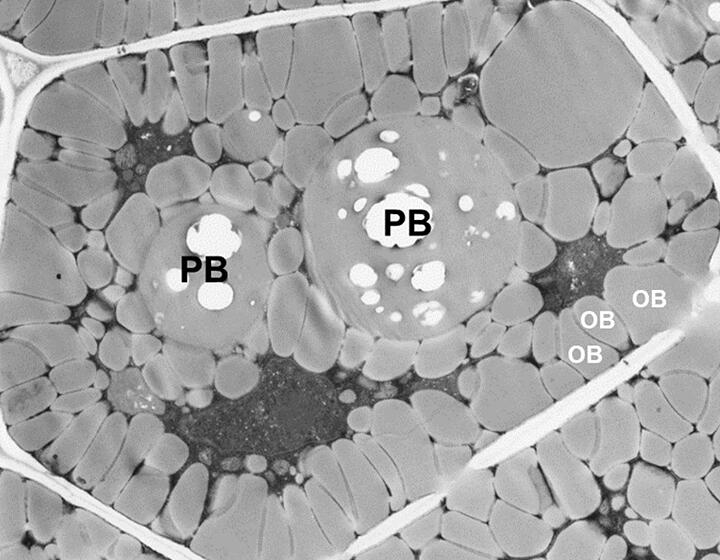Plant seeds accumulate large amounts of certain proteins, but the mechanism involved was not well understood. Using the model plant Arabidopsis, a joint research group led by Specially Appointed Assistant Professor Masatake Kanai and Associate Professor Shoji Mano of the National Institute for Basic Biology (NIBB) has revealed the presence of a sequence at the end of genes coding for seed storage proteins that is essential for the massive accumulation of those proteins. By adding this sequence to the gene coding for interferon, the mass synthesis and accumulation of the protein were successfully achieved. The results have been published in the journal Scientific Reports.

Plant seed cells have well-developed storage organelles for storing substances, and these occupy most of the cell volume. The large gray sphere with white spots in the center of the cell is the protein body (PB), a cell organelle that stores proteins, and the small gray sphere without spots that fills in the gaps is the oil body (OB), which stores oil.
Provided by NIBB
Seeds accumulate large amounts of nutrients, such as carbohydrates, fats, and proteins, to aid their initial growth immediately after germination. Although plants produce tens of thousands of proteins throughout their body parts, only a few types accumulate in seeds. These so-called seed storage proteins account for more than 90% of all proteins. However, it was unclear how seeds synthesize and accumulate large amounts of only certain proteins.
The research group analyzed the 12S1 gene encoding 12S1 protein (an Arabidopsis seed storage protein) to search for the region required for coding massive protein accumulation. They discovered that the 3-prime untranslated region (3′UTR) at the end of the gene is essential for massive protein accumulation in seeds.
To test whether this 3′UTR could function in other genes, the sequence was added to the end of the gene encoding malate dehydrogenase (pMDH1), a protein that does not normally accumulate in seeds. As a result, a large amount of pMDH1 accumulated in the seeds.
Additionally, by adding the 3′UTR of the 12S1 gene to the end of the gene encoding interleukin 28B (IL28B; one of the interferons and a candidate therapeutic agent for hepatitis C virus) and introducing the modified gene into Arabidopsis, a large amount of interleukin 28B was successfully accumulated in Arabidopsis seeds. The results of this study revealed one aspect of the mechanism behind the accumulation of specific proteins in plant seeds.
In the future, further clarification of the function of the 3′UTR will render possible the production of biopharmaceuticals and industrial enzymes from plant seeds. Protein production by plant seeds is expected to be a cheaper and safer system than the current use of microorganisms or cultured cells.
This article has been translated by JST with permission from The Science News Ltd. (https://sci-news.co.jp/). Unauthorized reproduction of the article and photographs is prohibited.




